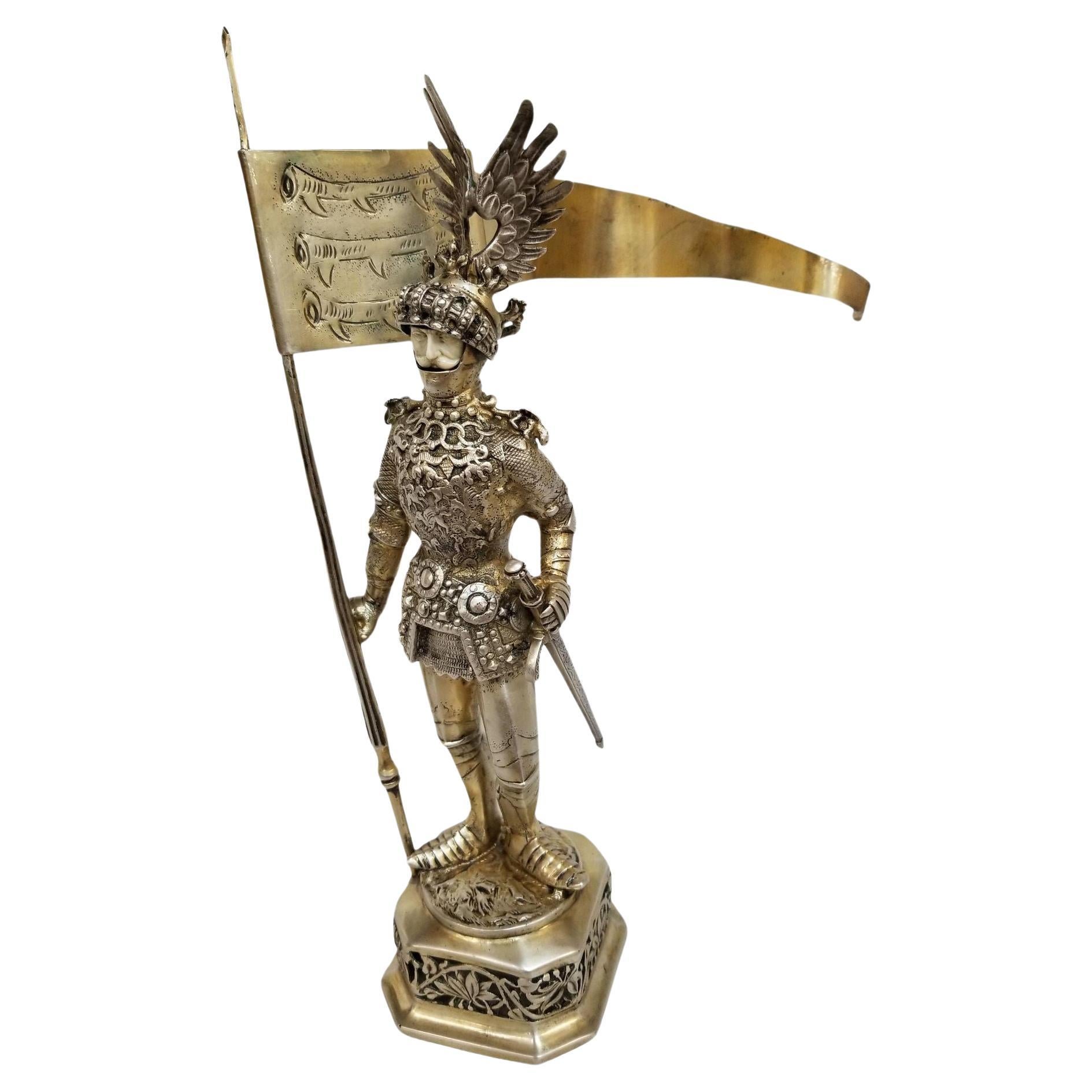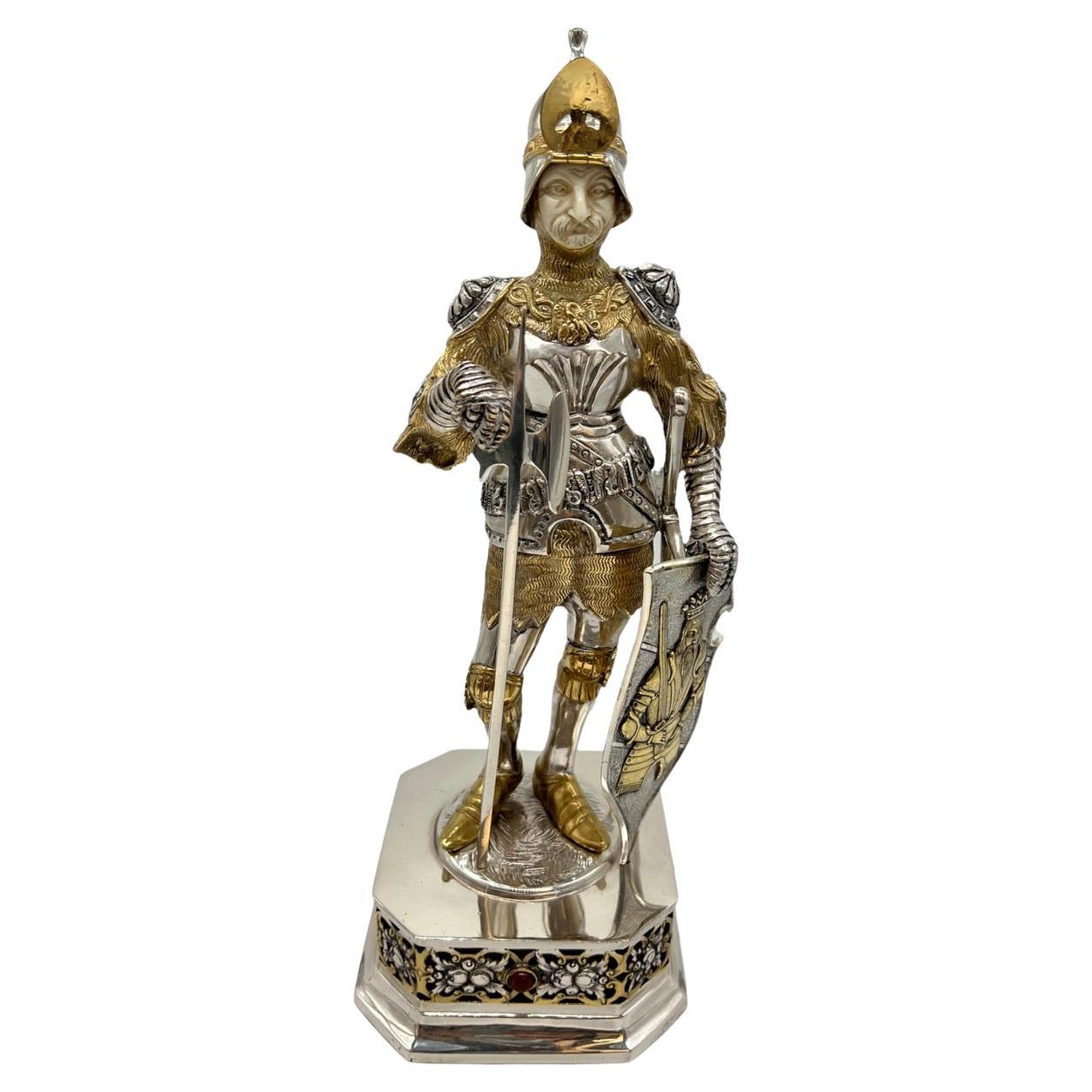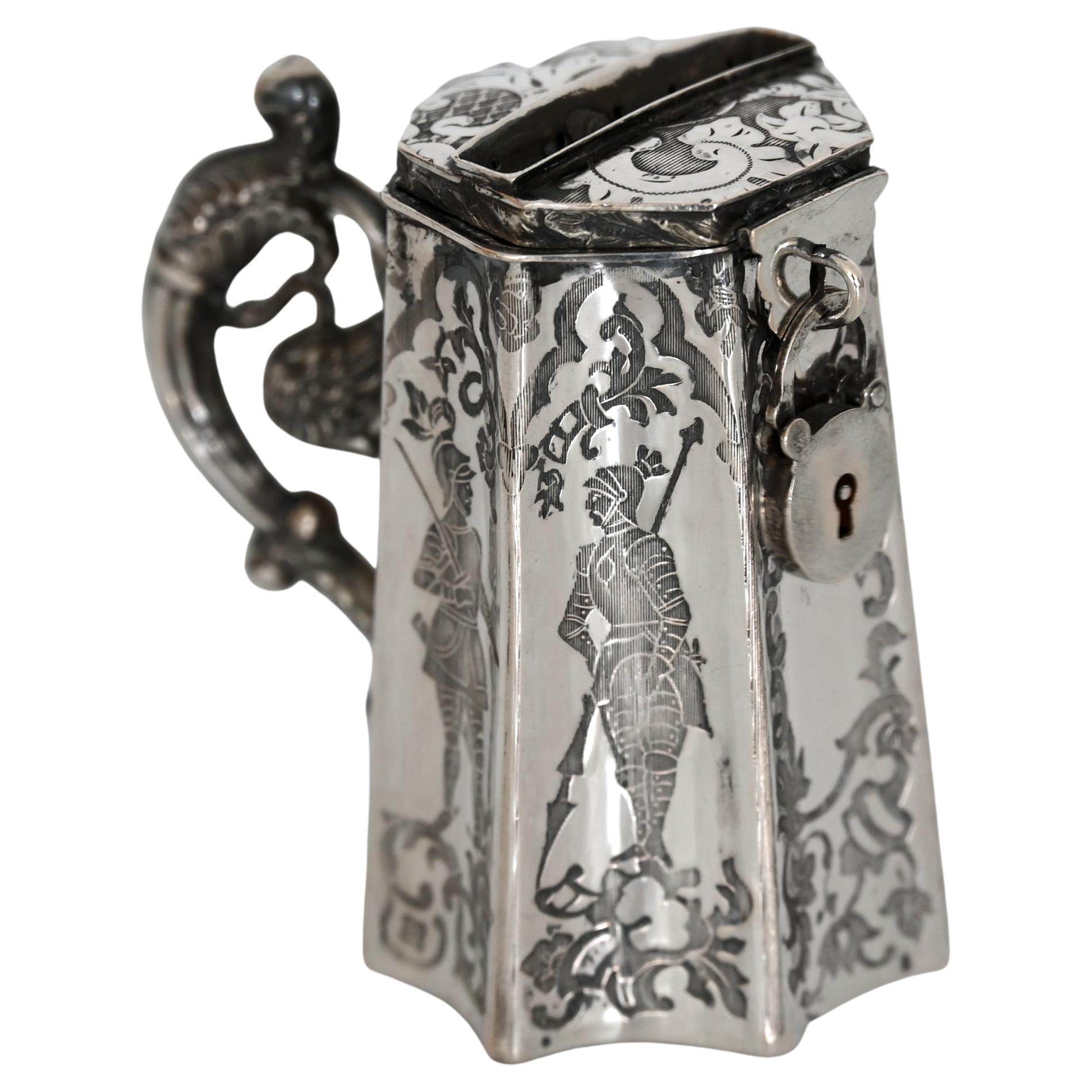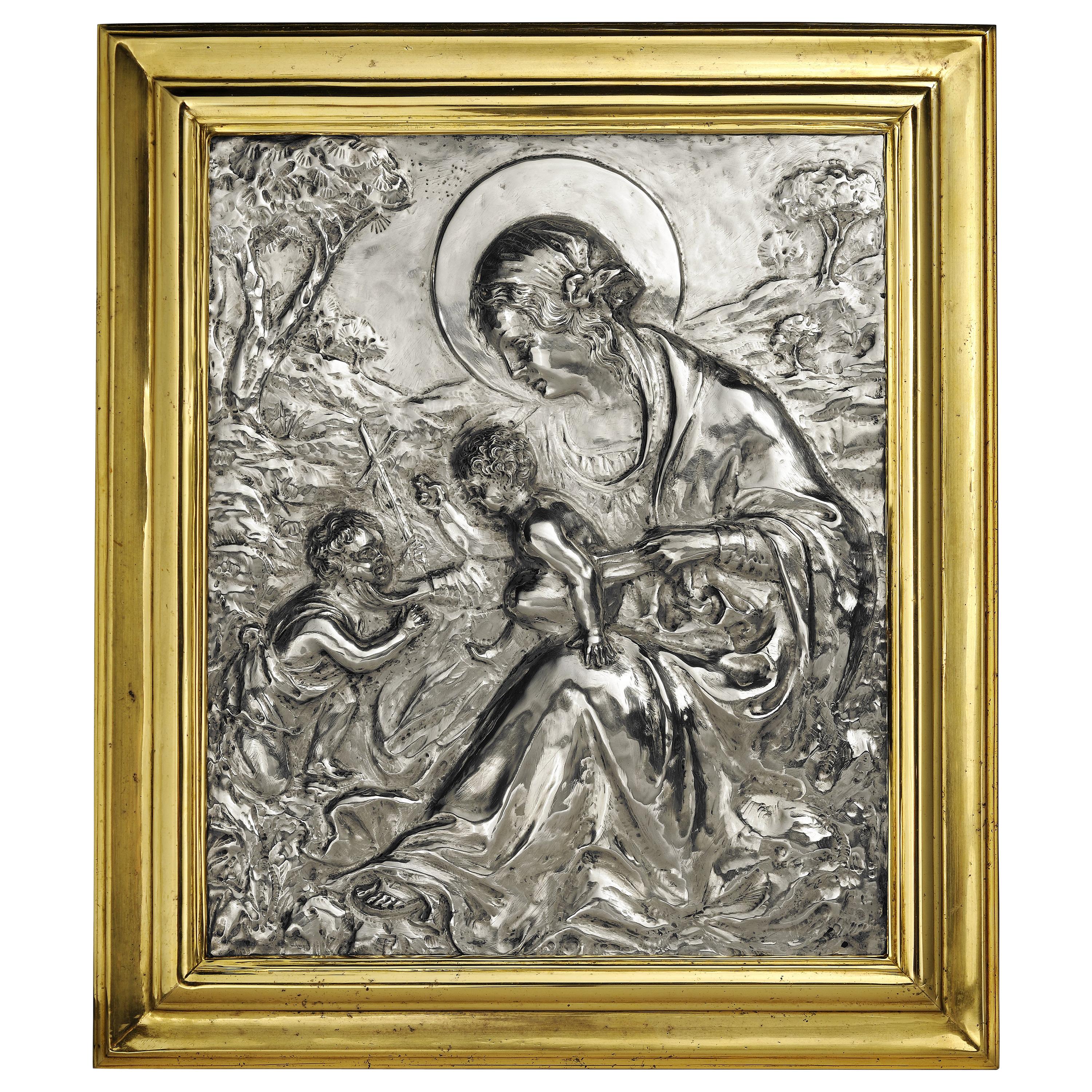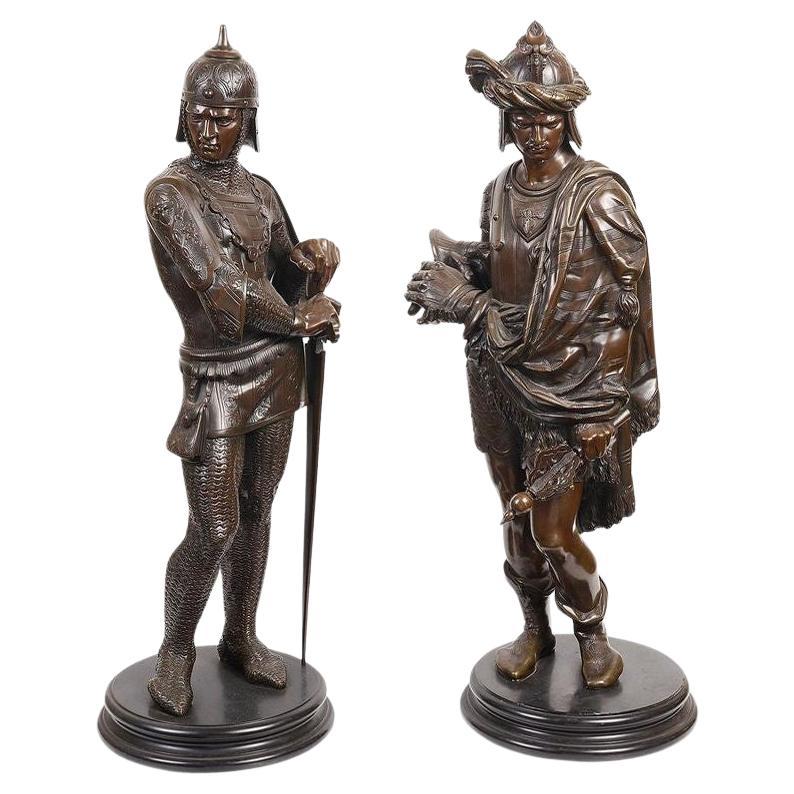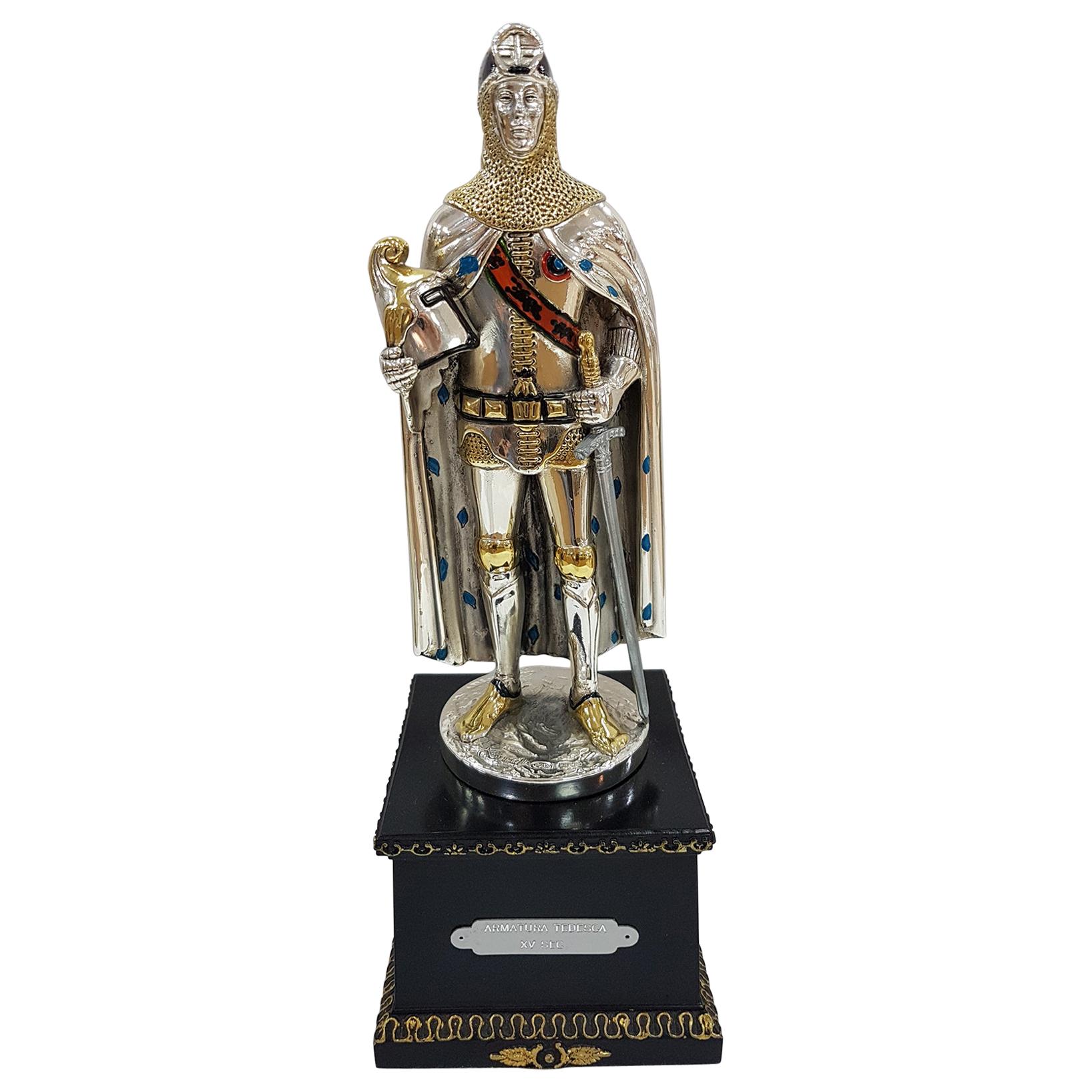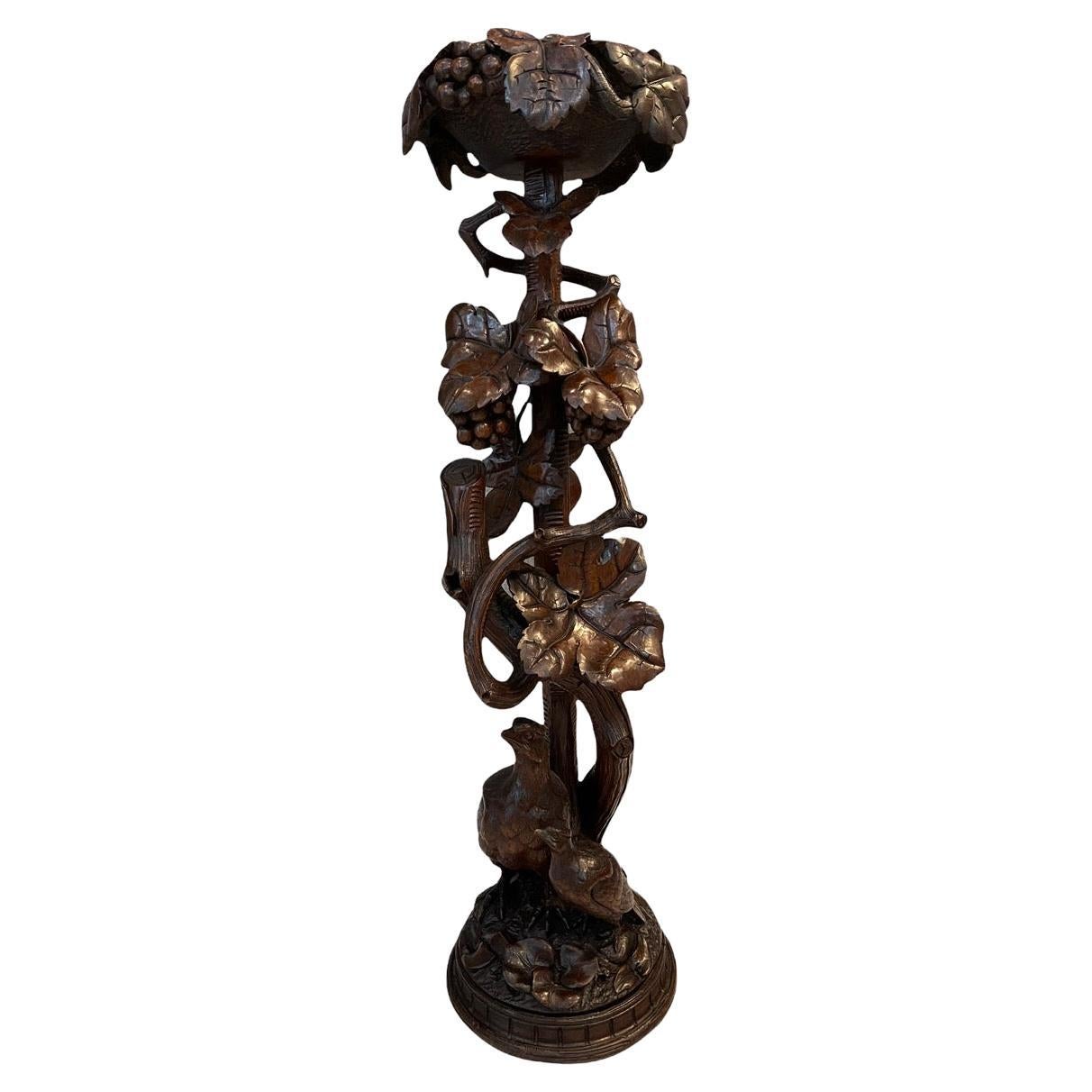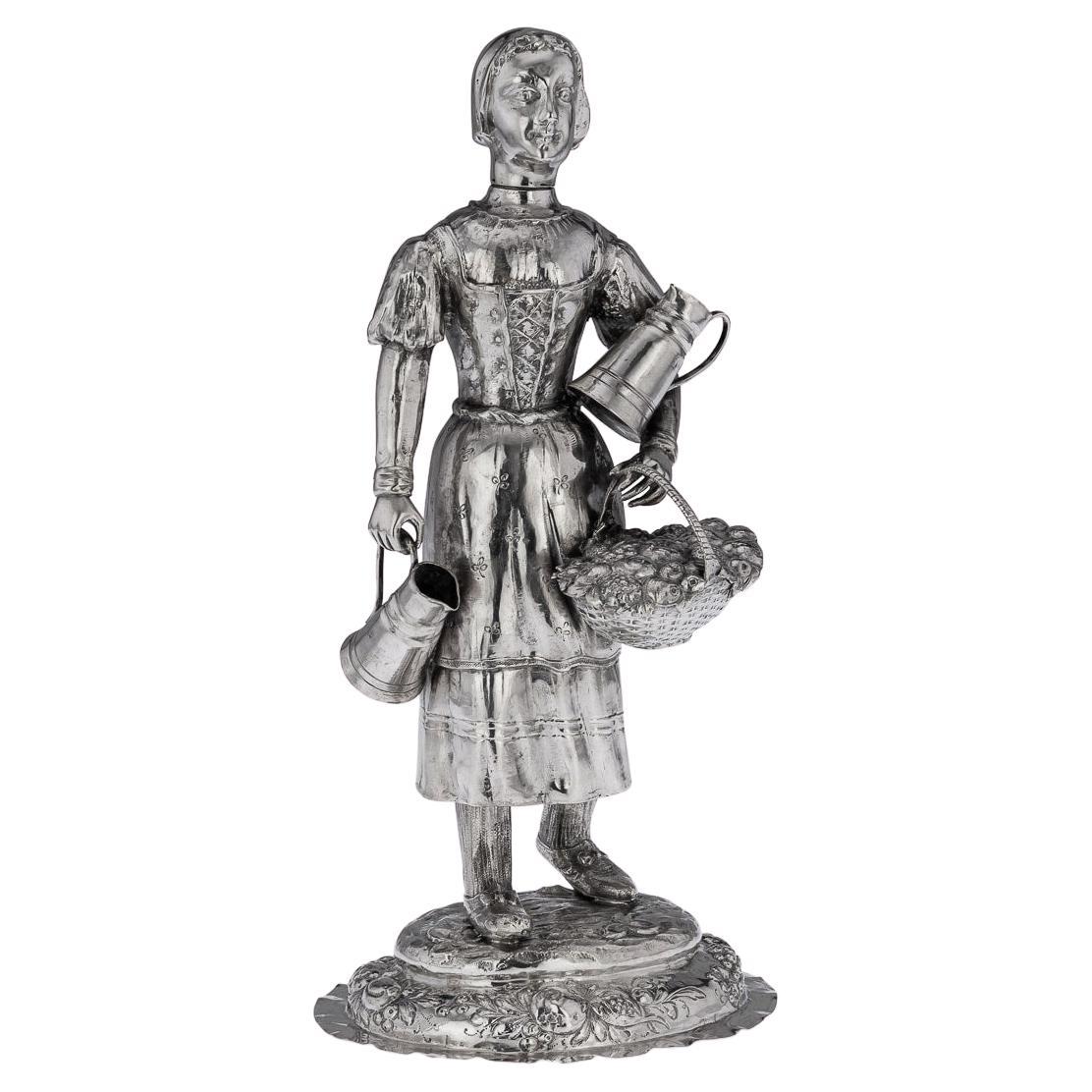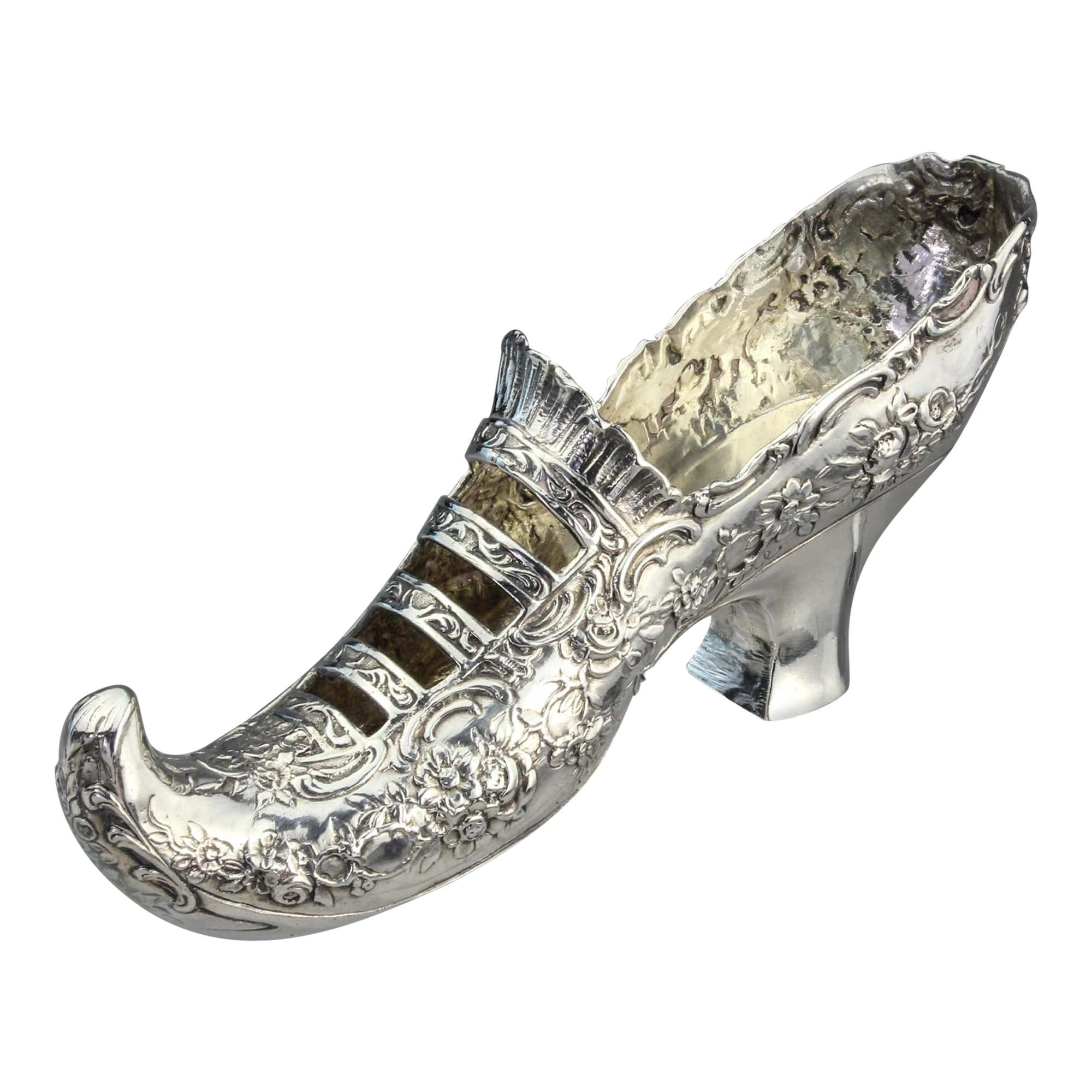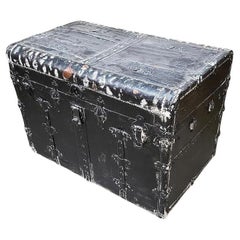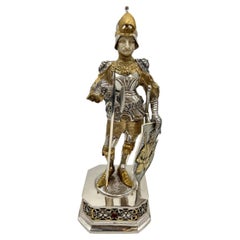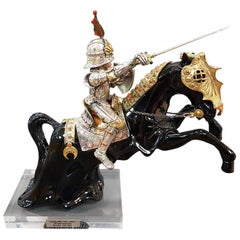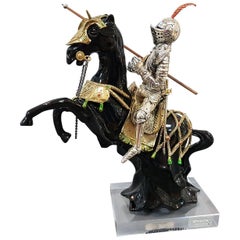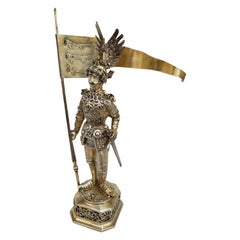
19th Century Sterling and Vermeil Silver Knight with Staff Flag, Germany
View Similar Items
Want more images or videos?
Request additional images or videos from the seller
1 of 11
19th Century Sterling and Vermeil Silver Knight with Staff Flag, Germany
About the Item
- Dimensions:Height: 10.5 in (26.67 cm)Width: 5.5 in (13.97 cm)Depth: 9.5 in (24.13 cm)
- Style:Medieval (In the Style Of)
- Materials and Techniques:
- Place of Origin:
- Period:
- Date of Manufacture:1890
- Condition:Wear consistent with age and use. Original.
- Seller Location:Van Nuys, CA
- Reference Number:Seller: 201904191stDibs: LU947416960312
About the Seller
4.6
Gold Seller
These expertly vetted sellers are highly rated and consistently exceed customer expectations.
Established in 1969
1stDibs seller since 2012
1,093 sales on 1stDibs
Typical response time: 2 hours
More From This SellerView All
- Sterling Silver 19th Century Knight in Shinning ArmorLocated in Van Nuys, CAThis antique sterling silver knight figurine from the 19th century is a captivating masterpiece. Dressed in full medieval armor with a staff and fl...Category
Antique 19th Century American Medieval Figurative Sculptures
MaterialsSilver
$5,960 Sale Price20% Off - 19th Century Wood and Metal Steamer Trunk with Leather EdgesLocated in Van Nuys, CA19th Century Wood and Metal Steamer Trunk with Leather Edges, the trunk has been repainted and repaired.Category
Antique 1890s American Trunks and Luggage
MaterialsMetal
- Vintage Decor Silver plated Stand with Bakelite BallLocated in Van Nuys, CAIntroducing a charming piece of vintage decor: a silver-plated stand adorned with a Bakelite ball. This elegant stand exudes timeless sophistication, blending the lustrous allure of ...Category
Vintage 1970s Abstract Sculptures
MaterialsBakelite
- 19th Century Wood Rice ContainerLocated in Van Nuys, CAHailing from the culturally vibrant Shanxi Province of China, this stunning rice container is a true masterpiece crafted with precision from Elm and tr...Category
Antique 1850s Chinese Decorative Baskets
MaterialsMetal
- French 19th Century Crystal and Glass Girandole Table LampLocated in Van Nuys, CAThis 19th century French girandole features a hand-etched base, four tiers of brass embellishments and crystal accents. The girandole was originally converted to electric around the ...Category
Antique 19th Century French Candle Holders
MaterialsCrystal, Brass
- 19th Century Candlestick Holder from EnglandLocated in Van Nuys, CAStep back in time with this captivating 19th Century Candlestick Holder from England. Crafted with meticulous attention to detail, this piece is a testament to the craftsmanship of a...Category
Antique Early 19th Century Candlesticks
MaterialsMetal
You May Also Like
- 19th Century German Extremely Detailed Sterling Silver and Gold Gilt KnightLocated in North Miami, FL19th Century German extremely detailed sterling silver and gold gilt knight figure. Knight in full suit of armour, carved face beneath a hinged visor made of white bone. The knight i...Category
Antique 19th Century German Sterling Silver
MaterialsStone, Sterling Silver
- 20th Century Made in Italy Sterling Silver Horse and Knight ArmourBy Argenteria EtruriaLocated in VALENZA, ITHorse in black lacquered resin with a sterling silver armor with Russian 14th century knight in sterling silver armor with golden and enameled details.Category
Vintage 1980s Italian Medieval Sterling Silver
MaterialsSterling Silver
- 20th Century Sterling Made in Italy Silver Horse and Knight ArmourBy Argenteria EtruriaLocated in VALENZA, ITHorse in black lacquered resin with a sterling silver armor with Italian XIV Century Knight in sterling silver armor with golden and enamelled details.Category
Vintage 1980s Italian Medieval Sterling Silver
MaterialsSterling Silver
- Terracotta Bas Relief Greek Horses and Knights, End 19th CenturyBy Europa AntiquesLocated in Madrid, ESTerracotta bas relief Greek horses and knights end 19th century Italy Classic scene with four horses, a character on horseback and a character on the ground, a dove in the background...Category
Antique Late 19th Century Italian Modern Busts
MaterialsTerracotta
$1,311 Sale Price20% Off - 19th Century Italian Sterling Silver Madonna, circa 1830Located in Milano, ITEmbossed and engraved silver plaque La Madonna del lago (The Madonna of the Lake) Probably Milan, post 1824 Brass frame It measures 16.14 in x 13.85 in (41 x 35.2 cm) and it weighs 10.357 pounds (4.698 g): silver 1.31 pounds (598 g) + brass 9.03 pounds (4.100 g) State of conservation: some abrasions on the bottom. The frame is old, but not original. The plaque is made up of a sheet of embossed and engraved silver, and held in a solid brass frame. It depicts the “Madonna del lago” – “Madonna of the Lake” - (the Madonna with Child and San Giovannino) by Marco d'Oggiono (Oggiono, 1474 circa - Milan, 1524 circa), while changing only the background landscape. Almost certainly the subject reproduced in the plaque was taken from a famous engraving by Giuseppe Longhi (Monza, 1766 - Milan, 1831), one of the greatest engravers of his era. The silver is unmarked, probably because originally the Madonna was due to be exposed in a church: sometimes precious metals destined for worship and liturgical use would be exempted from payment and were, therefore, not marked. It is very likely that the plaque was made in Milan because in this city in 1824 the engraving by Giuseppe Longhi was made and printed. In addition, in Milan, the alleged lost painting by Leonardo da Vinci in his Milanese period (1482-1500) would be produced; this is the painting from which Marco d'Oggiono took his version. The painting Marco d?Oggiono was one of Leonardo da Vinci's most brilliant students and collaborators (D. Sedini, Marco d’Oggiono, tradizione e rinnovamento in Lombardia tra Quattrocento e Cinquecento, Roma 1989, pp. 151-153, n. 56; p. 225, n. 124, with previous bibliography). His style reflects in every way that of the Tuscan Maestro, so much so that he was the one who executed some copies of da Vinci's paintings. The execution of the “Madonna del Lago” probably draws inspiration from a lost painting by the Maestro, created while he was living in Milan (1482-1500). There are many similarities with other works by Leonardo such as the “Vergine delle rocce” or the “Vergine con il Bambino e San Giovannino, Sant’Anna e l’Agnello”. The painting, from which the drawing and then the famous engraving were taken, is found today at the M&G Museum of Bob Jones University in Greenville, South Carolina, where it came to rest after the sale of the Harrington Collection in London in 1917. The work appears in the inventories of the collection of Napoleon and Joséphine Bonaparte at the castle of Malmaison, before 1809. The Malmaison building was born and developed in the 17th and 18th centuries. In the 18th century it belonged to Jacques-Jean Le Coulteux du Molay, a wealthy banker. Later, during the Directory, Joséphine Bonaparte de Beauharnais bought it on April 21st, 1799, but settled at the castle definitively only after her husband separated from her in 1809. She remained there until 1814, the year of her death. When Joséphine died, the estate passed to her son Eugène de Beauharnais, who moved to Munich with his whole family in 1815, bringing with him the collection of paintings he inherited from his mother. Eugène died in 1824 and his wife Augusta of Bavaria (von Bayern), unable to keep it, in 1828 sold the Malmaison to the Swedish banker Jonas-Philip Hagerman. It is likely that in this period Augusta also sold part of the paintings inherited from her husband, including the “Madonna del Lago”. This painting then came into the possession of Leicester Stanhope, fifth Earl of Harrington (1784 - 1862) and then was passed down to his descendants. In 1917, at the death of Charles, eighth Earl of Harrington, his brother Dudley inherited the title and properties and he put up a part of his collections for sale. Among these, precisely, the painting by Marco d'Oggiono was to be found. On the occasion of that auction the painting was presented as a work by Cesare da Sesto, by virtue of a handwritten note by the Countess of Harrington on the back of the table. However, already in 1857, the German critic Gustav Waagen had identified Marco d'Oggiono as the author of the painting, then exhibited in the dining room of Harrington House in London (Treasures of Art in Great Britain, in 4 volumes, London, 1854 and 1857). The engraving Giuseppe Longhi was one of the most renowned engravers in Italy between the end of the 18th century and the first quarter of the 19th century. In 1824 Giuseppe Longhi, based on a design by Paolo Caronni, made a famous engraving of the painting of Marco d?Oggiono. The activity of Longhi was then at the peak of his notoriety, enough to earn him very substantial commissions; it is not risky to suppose that some of his successful engravings were also reproduced using other means: in our case in silver. (A. Crespi, a cura di, Giuseppe Longhi 1766–1831 e Raffaello Morghen...Category
Antique 1820s Italian Neoclassical Sterling Silver
MaterialsSterling Silver, Brass
- 19th Century Biedermeier Money Box German Silver Engraved with Knight and LadyLocated in Epfach, DEA rare money box from the Bidermeier period in silver with small lock that can be opened and closed without a key. Very special is the fine engraving on the seven fields, which are ...Category
Antique 19th Century German Decorative Baskets
MaterialsSilver
Recently Viewed
View AllMore Ways To Browse
English Flag
German Medieval
Antique Knight Armor
Medieval Armor Used
German Knight
Coats Of Armor
Antique Medieval Armor
Antique German Flag
Brown Visor
German Silver Knight
Hanau Neresheimer
Full Body Armor
French Bas Relief
Small Bronze Sculpture 19th
Antique Quiver
Winged Cherub
Bronze Emperor
Marble Bronze Flowers
